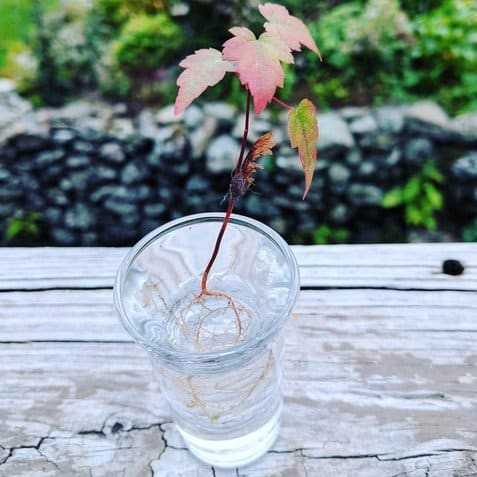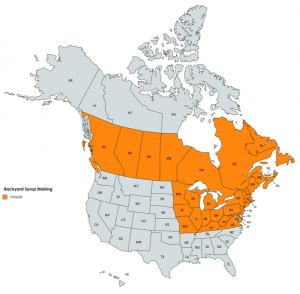A very young red maple seedling rescued from the garden and waiting to be planted in our sugar woods. Cultivating red maples in your sugar woods can help diffuse the virulence of pests, such as tent caterpillars, that would otherwise wreak havoc on your sugar stand!
In this blog, we have identified three simple steps backyard sugar makers can take to care for their sugar woods in a changing climate. We’ve covered the first part of step 1: eradicating invasive species (mapping invasive species on your property) and will cover the second part, removal, in its appropriate season (which is fall, thank goodness – it’s been so dang HOT!) That leaves (2) cultivating an ideal suite of tree species, and (3) protecting riparian areas and other habitat to support diversity of non-tree species. Today we are going to cover step two.
Cultivating an ideal suite of tree species sounds a bit intimidating – and it certainly can be as complicated as you’d like to make it, says Nancy Patch, County Forester for the Vermont counties of Franklin and Grand Isle. But it doesn’t have to be that way. Remain calm and read on.
First, some background. It may come as news to you (as it did to me) that there are different types of forests, even here in sugar country. (Psst. Do you know how big sugar country is? See the map below to find out.) Well, there are. And the kind that has sugar maples in it is called northern hardwood forest. Chances are, you are in a northern hardwood forest if you see sugar maple, yellow birch, American beech and white ash. Eastern hemlocks and white pine are also commonly found there. The northern hardwood forest has sub-types; all of these sub-types contain basically the same suite of eight tree species with a couple of additions and/or subtractions. Five or six of these sub-types contain sugar maple. And the best site conditions for sugar maple occur in what is known as the rich northern hardwood forest.
A forest community is rooted (no pun) in its soil. And the rich northern hardwood forest, as its name suggests, has nutrient-rich soil that supports a highly-productive forest dominated by sugar maple, but also including white ash, basswood, sweet birch, bitternut hickory, black cherry, yellow birch, hophornbeam, butternut, and sometimes American beech. The rich northern hardwood forest supports a wide variety of non-tree species as well, including the easily-identifiable “indicator species” of blue cohosh, maidenhair fern, wild leek and duchman’s breeches.
Left to its own devices, as in any other ecosystem, the flora in the rich northern hardwood forest balance in to a supportive companionship – a co-beneficial relationship – that, in part through its support of fauna, helps it resist pests and disease. Think companion planting in your garden – same concept. In other words, when the rich northern hardwoods forest contains its ideal suite of trees, it operates at its healthiest and most resilient level. When one or more species are selectively cut, or selectively planted, it doesn’t. Health is good, obviously. And resiliency is what any living system needs to cope with change – including forests and climate change.
So, this means that your job as custodian of your forest is to figure out which sub-type of northern hardwood forest you live in, figure out if you have the ideal proportion of the ideal species of trees on your forest, and, if not, selectively cut, plant and/or cultivate so that you do. Easy, right?
Not, really. No. Finding out what sub-type you have will take some research, and the true answer lies in analysis of the soil, notes Nancy. And do you know how to take a statistically significant survey of the number of each tree species you have? Because I don’t. Not to mention that foresters tend to work on the 250-acre level, so goodness knows whether a five, ten, or twenty-five acre plot of land can even be analyzed this way. I didn’t even want to ask.
This is when it is good to know a forester like Nancy. “Homeowners can make an impact by just focusing on variability,” she says. According to Nancy, it is enough to simply walk in your woods and catalog all of the species of trees you find there – including the understory (young trees). If what you find there is reasonably diverse – say around eight species – that’s great. You can care for your woods by just not cutting all or most of any species down. If what you find is not monocultural (sugar maple only) but is non-diverse (only a few species of trees) “consider planting an oak or two,” suggests Nancy. Oaks are great companion plants in northern hardwood forest; they are great habitat for moths, butterflies and song birds and provide a food source for bear, turkey and deer. They are also projected to do well in a warming climate (or a “climate-change winner” as Nancy says). If you do have a sugar maple monoculture, according to Nancy, “planting hemlocks and red maples can help diminish the virulence of tent caterpillar invasions.” Just take a couple of hours to look around, find out how diverse your woods are, and act accordingly. I can DO that!
So, the other day, when I should have been typing (I had planned to be typing. I needed to be typing!), I just couldn’t type. So I took the dog outside with The Sibley Guide to Trees. (What I wanted to have was Forest Trees of Vermont, but, alas, not in our local public library. It is now on my Christmas list.) And we ambled for a couple of hours. We saw mature red maple, sugar maple, yellow birch, paper birch, eastern hemlock and American beech throughout our ten acres, and some white ash and northern red oak in the understory. Near the house, there were also big white pine and little quaking aspen, staghorn sumac, striped maple and smooth alder. With eight or more species of trees, I’m solidly in the “already have diversity” camp, which is great, even though I don’t boast a piece of the rich northern hardwood forest. So I can help my woods stay resilient by just staying the course. Whew. Love it when that happens.
So if you should be typing, had planned to be typing, and need to be typing, but just can’t, get out there in the woods and look around for a while to see what you can see – you’ll probably be glad you did!
Sugar country is bigger than you think. People make maple syrup in their backyards in twenty U.S. states and most of Canada


